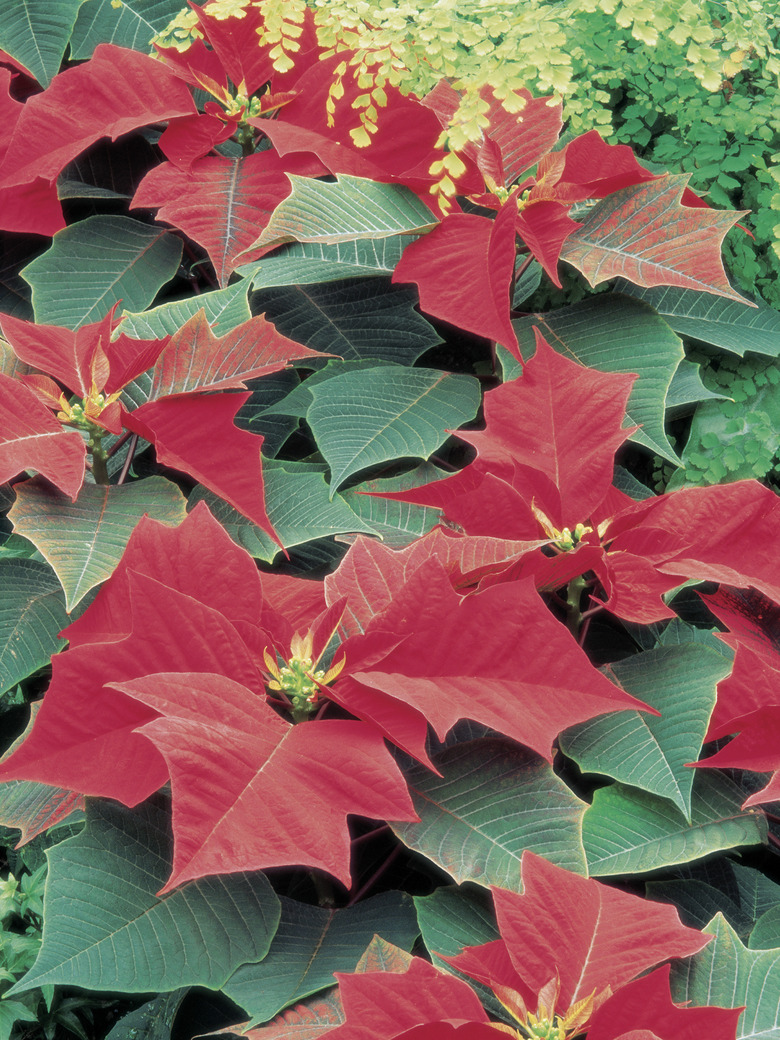How To Rid A Poinsettia Of Whiteflies
Poinsettias (Euphorbia pulcherrima), so familiar during the winter as houseplants, grow as perennials in U.S. Department of Agriculture plant hardiness zones 9 through 11. These plants produce colorful bracts and brighten rooms for the holidays, so it can cause concern when whiteflies infest a poinsettia. Whitefly adults look like tiny, delicate moths that are covered with a powdery white wax. An immature whitefly, or nymph, is flat, oval and mostly immobile where it feeds on leaf undersides. Both adults and nymphs feed on poinsettias, stunting plant growth when an infestation is heavy. Typically more troubling is that whiteflies produce honeydew, a sugary substance, as a byproduct of feeding. Honeydew gives surfaces it drips onto a shiny look and supports the growth of the unattractive sooty mold fungus.
- Poinsettias (Euphorbia pulcherrima), so familiar during the winter as houseplants, grow as perennials in U.S. Department of Agriculture plant hardiness zones 9 through 11.
- These plants produce colorful bracts and brighten rooms for the holidays, so it can cause concern when whiteflies infest a poinsettia.
Step 1
Step 1
Pinch off, bag and dispose of the oldest leaves on the poinsettia that are heavily infested with immature whiteflies and eggs. Always wear gloves when touching a poinsettia because the sap can irritate skin.
Step 2
Step 2
Shake the poinsettia gently and vacuum up whitefly adults that fly into the air above the poinsettia using a small, hand-held vacuum. Place the vacuum bag in the freezer overnight before disposing of its contents.
Step 3
Step 3
Wipe the leaves of the poinsettia down with a moist sponge or cloth, concentrating on leaf undersides. This may control the pests.
Step 4
Step 4
Smear petroleum jelly onto a small piece of yellow cardboard or buy yellow sticky traps and place one or more near the poinsettia. Keep the yellow sticky traps out of the reach of children or small pets to avoid a sticky mess.
- Pinch off, bag and dispose of the oldest leaves on the poinsettia that are heavily infested with immature whiteflies and eggs.
Step 5
Step 5
Blend 2 tablespoons of mild dish washing detergent with 1 gallon of lukewarm water. Pour the solution into a spray bottle and spray a small, inconspicuous section of the poinsettia. Rinse the soap spray off of the plant after a few minutes. Monitor the area you sprayed for about a week to make sure it didn't damage the poinsettia. If the sprayed part of the plant was damaged, decrease the concentration of the soap or use a different soap and test again. If no injury occurred, spray the entire plant thoroughly, wait a few minutes, then rinse off the soap. Spray a week later, if needed.
- Blend 2 tablespoons of mild dish washing detergent with 1 gallon of lukewarm water.
- Pour the solution into a spray bottle and spray a small, inconspicuous section of the poinsettia.
Tip
Carefully inspect poinsettias and any other plants before you buy them or bring them into your home to avoid introducing pests or diseases.
Warning
Keep children and pets away from poinsettias because the sap can irritate skin and eating it may cause vomiting or other stomach problems. Call a poison control center, or visit your doctor or veterinarian if you suspect a problem.
Things Needed
- Gardening gloves
- Bag
- Handheld vacuum
- Damp sponge or cloth
- Small piece of yellow cardboard
- Petroleum jelly
- Mild dish soap
- Spray bottle
References
- University of Illinois Extension: Poinsettia May Include Whiteflies
- Iowa State University Extension: Check Your Houseplants For Whiteflies
- University of Florida IFAS Extension: Clean Up Pests With Soap
- University of Missouri Extension: Managing Whiteflies on Indoor and Outdoor Plants
- University of Rhode Island Landscape Horticulture Program: Poinsettias
